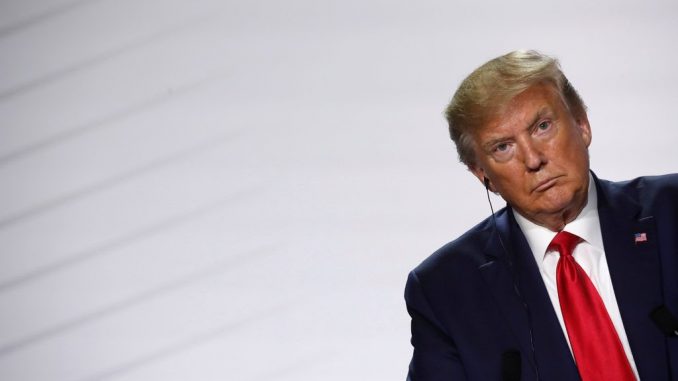
Explore what’s moving the global economy in the new season of the Stephanomics podcast. Subscribe via Pocket Cast or iTunes.
An enduring U.S. expansion puts President Donald Trump on course to win re-election in 2020, according to economic models with a track record of predicting who wins the White House.
The forecasts from Yale University professor Ray Fair, Oxford Economics Ltd. and Moody’s Analytics Inc. are based on Trump being boosted at the ballot box by steady economic growth, an historically tight labor market and limited inflation.
Such an outlook justifies Trump’s push to harness what he’s called the “greatest” economy to return him to power a year from Sunday. It challenges some opinion polls which show his disapproval rating hovering near 54% amid an impeachment inquiry and polarized politics.
“The election is Trump’s to lose,” said Mark Zandi, chief economist at Moody’s Analytics. “Trump wins if the economy and his approval rating are about the same a year from now as today, and turnout is typical. But if the economy stumbles, his popularity flags or Democrat turnout is big, the Democrats win.”
The economy expanded at a 1.9% pace in the third quarter and unemployment is close to its lowest in a half-century, government data showed last week. While manufacturing has been hurt by the U.S.-China trade war, consumers continue to spend in a sign voters are still confident about the economy. A Bloomberg Economics model sees the chances of an election-year recession at just 27%.
(snip)
They also assume the White House incumbent is credited with the economy’s performance which may not be the case if voters zero in on the effects of the trade war Trump is waging or relatively slow growth in middle class incomes.
“We stress that non-economic factors are likely to play an outsize role in this election, including policy and political developments (such as the impeachment inquiry) as well as factors like race, gender and ‘likability’,” Gregory Daco and James Watson, economists at Oxford Economics, wrote in an October report.
Here’s the rundown of what the models show for now:
Yale University Professor Ray Fair
Yale’s Ray Fair has been predicting the outcomes of presidential elections in the U.S. since the 1970s. His current call is for a Trump victory amid an economy that is showing “neither boom nor bust.”
His latest analysis, published Oct. 30, predicts Trump will beat the Democrat candidate by about 4 percentage points, around what it’s suggested for the past year. That prediction relies on gross domestic product and inflation, and sees annualized growth in the lead-up to the election in 2020 of about 2%, around where it is now, and inflation above 2% for Trump’s presidency.
If the economy booms, Fair’s model sees the Democratic presidential candidates losing votes but if there’s a recession in 2020, the Democrats have a better chance. It would take a dip of 5% in real per capita GDP for Democrats to gain an edge over Trump on the presidential ticket, the model shows.
“If it really is different this time, that inequality is much higher and people aren’t voting on the economy, then this kind of work isn’t very helpful because it’s based on past experience,” Fair said by phone Friday. “And there’s no way you can test that ahead of time. So take it with a grain of salt.”
Moody’s Analytics
Led by Zandi, the work of Moody’s economists has accurately predicted each election outcome for two decades with the exception of Trump’s 2016 victory.
They focus on regional growth and break the economy down into the health of personal finance, stocks and the labor market. They also allow for Trump’s low-but-stable approval rating and components such as party “fatigue.”
Their forecast, based on an average of the three measures, is for Trump to win 332 electoral votes, more than the 305 he garnered in 2016 and the 270 need to win.
Most of the Trump support, the Moody’s team said, comes from upbeat consumers. A so-called pocketbook measure, which relies on gas and home prices, and real personal income, shows Trump winning with 351 electoral votes.
The stock market component of the Moody’s model sees Trump winning with 289 electoral votes as he benefits from the 35% rally in the S&P 500 Index since he took office in January 2017. The unemployment model, largely based on changes in states’ jobless rates and real income, also projects a Trump victory with 332 electoral votes.
Oxford Economics
Analysts at the firm see a 5-point win for Trump in the popular vote, even in the case of a recession, thanks to low unemployment, weak inflation, and relatively stable income gains.
Their model accurately predicted the popular vote in 16 of the last 18 elections, going back to 1948. They missed Richard Nixon winning in 1968 and Jimmy Carter in 1976.
The only way a Democrat would win the popular vote is if signs of a severe recession emerged next year, triggered by rising tariffs, lower corporate profits, and a stock market downturn, Oxford’s Daco and Watson said.
But for that to happen, unemployment would need to rise to 6.4% from 3.6% now, inflation-adjusted disposable incomes to fall and inflation to flat-line with the Republican only just losing, they said.
*see full story by Bloomberg